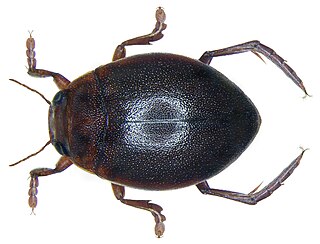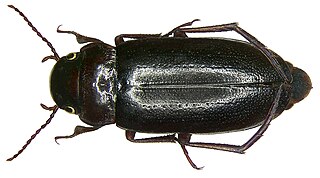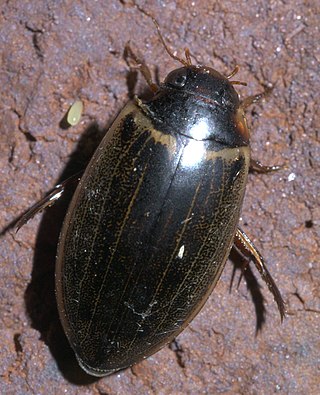
The Dytiscidae – based on the Greek dytikos (δυτικός), "able to dive" – are the predaceous diving beetles, a family of water beetles. They occur in virtually any freshwater habitat around the world, but a few species live among leaf litter. The adults of most are between 1 and 2.5 cm (0.4–1.0 in) long, though much variation is seen between species. The European Dytiscus latissimus and Brazilian Megadytes ducalis are the largest, reaching up to 4.5 cm (1.8 in) and 4.75 cm (1.9 in) respectively. In contrast, the smallest is likely the Australian Limbodessus atypicali of subterranean waters, which only is about 0.9 mm (0.035 in) long. Most are dark brown, blackish, or dark olive in color with golden highlights in some subfamilies. The larvae are commonly known as water tigers due to their voracious appetite. They have short, but sharp mandibles and immediately upon biting, they deliver digestive enzymes into prey to suck their liquefied remains. The family includes more than 4,000 described species in numerous genera.

Copelatus is a large genus of small diving beetles. There are some 470 described species in the genus, found worldwide, but they are most diverse in tropical South America, Africa and South-East Asia. Copelatus are often black or brown in color, many species of Copelatus possessing visible longitudinal furrows down the dorsal side of the wings of both sexes.
Carabdytes alutaceus is an endangered species of beetle in the family Dytiscidae. It is endemic to New Caledonia, in the southwest Pacific Ocean.

Agabus is a large genus of predatory aquatic beetles in the family Dytiscidae, proposed in 1817 by William Elford Leach and named after Agabus, an early follower of Christianity. The adult beetles are moderate-sized, 5 to 14 mm long. The genus is primarily Holarctic in distribution, with only a few species known from the Afrotropical and Neotropical realms. Three species of Agabus, namely A. clypealis, A. discicollis and A. hozgargantae are endangered according to the IUCN Red List. The division into subgenera is not widely accepted. However, a number of species groups are recognized after the works of David J. Larson and Anders N. Nilsson. The genus is probably polyphyletic or paraphyletic. In a recent study of mitochondrial DNA, Agabus was found paraphyletic with respect to several of the species groups of Platambus, a closely related genus in the tribe Agabini. Lately the taxonomy of the genus has been revised, and some groups of species were transferred from Agabussensu stricto to other genera in the tribe Agabini.

Laccophilus is a genus of water beetle found in nearly every temperate or tropical region in the world including but not limited to Europe, the Near East, the Nearctic, North Africa and the Oriental region. It contains the following species:

Hyphydrus is a genus of diving beetle native to the Palearctic, the Afro-tropical region, the Near East, North Africa. It contains the following species:

Hydaticus is a genus of predatory water beetle belonging to the family Dytiscidae. Hydaticus can be found throughout most of the world. There are 150 described species and 12 subspecies in two subgenera in the genus Hydaticus.

Cybister, is a genus of beetle in family Dytiscidae. They are found in much of the world, including all continents except Antarctica. As of 2021 there are 96 species and 9 additional subspecies among four subgenera in the genus.

Carabdytes is a genus of predaceous diving beetles in the family Dytiscidae. Carabdytes upin was formerly the sole species of this genus, but nine species in the genus Rhantus were transferred to Carabdytes as a result of research published by Balke et al. in 2017.

Prodaticus is a subgenus of beetles of the genus Hydaticus in the family Dytiscidae. These 143 species are in the subgenus Prodaticus:

Hydroglyphus is a genus of predaceous diving beetles in the family Dytiscidae. There are more than 90 described species in Hydroglyphus, found in Africa, Australasia, Indomalaya, and the Palearctic.

Canthydrus is a genus of beetles in the family Noteridae, containing the following species:

Meridiorhantus calidus is a species of predaceous diving beetle in the family Dytiscidae. It is found in North America and the Neotropics. This species was formerly a member of the genus Rhantus.
Carabdytes plantaris is a naturally uncommon species of diving beetle in the family Dytiscidae. It is endemic to New Zealand. For over a century, it was known from just a single specimen collected in 1880 "near Dunedin", and doubts were cast on whether it was actually a New Zealand species at all. In 1986, it was rediscovered when several were collected from a roadside pond near Lake Ellesmere. Carabdytes plantaris is now classed as "naturally uncommon" by the Department of Conservation.

Nartus grapii is a species of beetle in family Dytiscidae, found in the Palearctic. This species was formerly a member of the genus Rhantus.
Bidessini is a tribe of predaceous diving beetles in the family Dytiscidae. There are at least 40 genera and at least 630 described species in Bidessini.

Meridiorhantus is a genus of predaceous diving beetles in the family Dytiscidae. There are about five described species in Meridiorhantus, found in the Neotropics and North America. These species were formerly members of the genus Rhantus, but were moved to Meridiorhantus when it was created by Balke et al. in 2017.
Caperhantus is a genus of predaceous diving beetles in the family Dytiscidae. There is one described species in Caperhantus, C. cicurius. This species was formerly a member of the genus Rhantus.

Nartus is a genus of predaceous diving beetles in the family Dytiscidae. There are at least two described species in Nartus. These species were formerly members of the genus Rhantus, but were moved to Nartus when it was reinstated by Balke et al. in 2017.
















